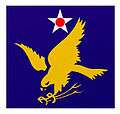487th Air Expeditionary Wing
| 487th Air Expeditionary Wing | |
|---|---|
|
BGM-109G Gryphon ready to launch | |
| Active | 1943–1945; 1983–1991, 2003 |
| Country |
|
| Branch |
|
| Engagements | European Theater of Operations[1] |
| Decorations | Air Force Outstanding Unit Award[2] |
| Insignia | |
| 487th Tactical Missile Wing emblem (approved May 1983)[3] |
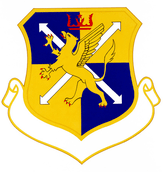 |
| Patch with emblem used by 587th Tactical Missile Group[note 1] |
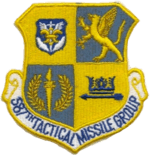 |
| Unofficial 487th Bombardment Group emblem[4] |
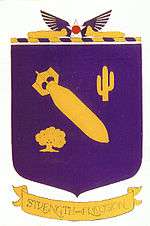 |
The 487th Air Expeditionary Wing is a provisional United States Air Force unit assigned to the United States Air Forces in Europe. As a provisional unit, it may be activated or inactivated at any time. The unit's last known assignment was in 2003 at Cairo West Airfield, Egypt, during Operation Iraqi Freedom. It was commanded by Brig. Gen. Randal D. "Randy" Fullhart (March 2003 – May 2003).
During World War II, its predecessor unit, the 487th Bombardment Group (Heavy) was an Eighth Air Force heavy bombardment unit in England, stationed at RAF Lavenham. It flew 185 combat missions, the last being on 21 April 1945.
It led the largest Eighth Air Force mission of the war on 24 December 1944. The object of the attacks, in which 1,400 bombers took part, escorted by 726 fighters, was to bomb eleven German airfields east of the Rhine while another 634 heavy bombers attacked communication centers west of the Rhine.
Brigadier General Frederick Castle was awarded the Medal of Honor for his actions during that mission. A portrait of the general hangs to this day in the Swan Hotel at Lavenham, which was one of his wartime haunts and whose then-landlord was a personal friend. He was the highest-ranking officer in the Eighth to be awarded the Medal of Honor.
History
World War II

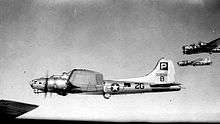
Activated 20 September 1943 at Bruning AAFd, Neb., and moved to Alamogordo AAFd, New Mexico, on 15 December 1944 to complete training. Ground unit left Alamogordo on 10 March 1944 for Camp Kilmer, New Jersey. and sailed on Duchess of Bedford on 23 March 1944, arriving in Gourock on 3 April 1944. The aircraft flew overseas on 23 March 1944, taking southern ferry route via Fortaleza Brazil to Dakar and on to RAF Valley, Wales. Then flying to Lavenham, East Anglia in early April 1944. The group was assigned to the Eighth Air Force, 3rd. Air Division, and the group tail code was a "Square-P" or "Box"-P. The group was based at Station 137, Lavenham, England. The group participated in Air Offensive Europe.
The group flew both the B-24 Liberator and the B-17 Flying Fortress as part of the Eighth Air Force's strategic bombing campaign and began combat in May 1944, bombing airfields in France in preparation for the invasion of Normandy, then targeted coastal defenses, road junctions, bridges and locomotives during the invasion. Aided Normandy ground forces on D-Day 6 June 1944. The unit's first commander was Lieutenant Colonel Beirne Lay, Jr., a prominent Hollywood screenwriter until he was shot down on 11 May 1944 in one of the group's earliest actions. He was shot down over enemy territory but evaded capture and was returned to duty. After the war, he wrote the screenplay for the 1949 film, Twelve O'Clock High.
The 487th Bomb Group(H) attacked German troops and artillery positions to assist British forces near Caen in July; struck gun emplacements to support the Allied effort at Brest in August and to cover the airborne attack on the Netherlands in September 1944. Flew a few missions against German industries, refineries, and communications during the period May–August 1944, but operated almost solely against strategic targets from August 1944, when conversion to B-17's was completed in March 1945.
The 487th also attacked oil refineries in Merseburg, Mannheim, and Dülmen; factories in Nuremberg, Hanover, and Berlin; and marshalling yards in Cologne, Münster, Hamm, and Neumünster. Aided ground forces during the Battle of the Bulge, December 1944 – January 1945, and turned again to support and interdictory operations in March 1945 as the Allies crossed the Rhine and made the final thrust into Germany.
Redeployed to the US July 1945. The aircraft left Lavenham in the first week of July 1945. The ground unit sailed on the Queen Elizabeth on 25 August 1945, and arriving in New York on 1 September 1945. The Group established at Drew Fd, Fla 3 September 1945, and inactivated there on 7 November 1945. Group nickname: "Gentlemen from Hell".
Cold War
From September 1956, the 587th Tactical Missile Group operated Air Force missiles. It was assigned to the 38th Tactical Missile Wing and stationed at Sembach Air Base, West Germany. It controlled Mace and Matador tactical cruise missiles at three dispersed locations 2.6 to 12.5 miles from Sembach. It was inactivated on 25 September 1962.
On 11 January 1982, the 487th Bombardment Group, and 587th Tactical Missile Group were consolidated (effectively merged on paper) and the merged unit became the 487th Tactical Missile Wing. This was a purely administrative, on-paper change.
Activated in 1983, the 487th Tactical Missile Wing was stationed at Comiso Air Station in Sicily. Equipped with BGM-109G Ground Launched Cruise Missile (GLCM). Inactivated as a result of the 1987 Intermediate-Range Nuclear Forces Treaty in 1991.
21st century
Converted to provisional status and activated as an Air Expeditionary Wing during 2003 invasion of Iraq in March 2003. Inactivated after 90 days of duty due to Air-Force intensive active combat phase of Iraqi invasion having been completed.
The following units were awarded Global War on Terrorism (Expeditionary) campaign participation credit on 14 July 2014 in accordance with AFCENT Special Order G-33994:[5]
- 487th Expeditionary Aircraft Maintenance Squadron
- 487th Expeditionary Civil Engineer Squadron
- 487th Expeditionary Communications Squadron
- 487th Expeditionary Logistics Readiness Squadron
- HQ 487th Expeditionary Medical Group
- HQ 487th Expeditionary Mission Support Group
- HQ 487th Expeditionary Maintenance Group
- 487th Expeditionary Maintenance Squadron
- HQ 487th Expeditionary Operations Group
- 487th Expeditionary Operations Support Squadron
- 487th Expeditionary Security Forces Squadron
- 487th Expeditionary Services Squadron
Lieutenant Colonel James S. McCready served repeatedly with the 107th Air Refueling Wing.[6] Upon leaving the active duty Air Force in 1992, he moved back to Western New York and joined the 107th Air Refueling Wing. Lt Col McCready excelled in numerous 107 ARW positions including Chief of Scheduling, Evaluator Navigator, and Tanker Plans. He has deployed as the Operations Officer for Operation Enduring Freedom, DECISIVE ENDEAVOR (3 times), and NORTHERN WATCH. Most recently, Lt Col McCready became Operations Group Commander for the 487th Air Expeditionary Wing during the invasion of Iraq.
Lineage
- 487th Bombardment Group
- Constituted as the 487th Bombardment Group (Heavy) on 14 September 1943
- Activated on 20 September 1943
- Redesignated 487th Bombardment Group, Heavy c. 5 April 1944
- Inactivated on 7 November 1945[1]
- Consolidated with the 587th Tactical Missile Group as the 487th Tactical Missile Wing on 11 January 1982[7]
- 587th Tactical Missile Group
- Established as the 587th Tactical Missile Group c. 3 August 1956
- Activated on 15 September 1956
- Inactivated on 25 September 1962[7]
- Consolidated with the 487th Bombardment Group as the 487th Tactical Missile Wing on 11 January 1982[7]
- 487th Tactical Missile Wing
- 487th Bombardment Group and 587th Tactical Missile Group consolidated as the 487th Tactical Missile Wing on 11 January 1982[7]
- Activated on 30 June 1983[8]
- Inactivated c. 27 May 1991
- Redesignated 487th Air Expeditionary Wing and converted to provisional status on 1 March 2003
Assignments
- II Bomber Command, 20 September 1943
- Second Air Force, 6 October 1943 – 13 March 1944
- 92d Combat Bombardment Wing, 5 April 1944
- 4th Bombardment Wing (Provisional), 22 November 1944
- 4th Combat Bombardment Wing, 16 February–24 August 1945
- Third Air Force, 3 September–7 November 1945
- 701st Tactical Missile Wing, 15 September 1956[9]
- 38th Tactical Missile Wing, 18 June 1958 – 25 September 1962[10]
- Sixteenth Air Force, 30 June 1983 – c. 27 May 1991
- United States Air Forces in Europe to activate or inactivate any time after 1 March 2003
Components
- 302d Tactical Missile Squadron: See 822d Tactical Missile Squadron
- 487th Tactical Missile Maintenance Squadron: 20 June 1983 – 27 May 1991
- 11th Tactical Missile Squadron, 15 September 1956 – 18 June 1958[11]
- 822d Tactical Missile Squadron (later 302d Tactical Missile Squadron): 18 June 1958 – 25 September 1962,[12] 20 June 1983 – 27 May 1991 (112 missiles)
- 836th Bombardment Squadron (2G), 20 September 1943 – 7 November 1945[13]
- 837th Bombardment Squadron (4F), 20 September 1943 – 7 November 1945[14]
- 838th Bombardment Squadron (2C), 20 September 1943 – 7 November 1945[15]
- 839th Bombardment Squadron (R5), 20 September 1943 – 7 November 1945[15]
Stations
|
|
Aircraft and missiles
- B-24 Liberator, 1943–1944
- B-17 Flying Fortress, 1944–1945
- BGM-109G Ground Launched Cruise Missile (1983–1991)
See also
References
Notes
- Explanatory notes
- ↑ The three missile groups of the 38th Tactical Missile Wing used the wing emblem with the group designations on the scroll.
- ↑ Aircraft is Ford B-24H-15-FO Liberator serial 42-52746. This plane was transferred to the 446th Bombardment Group in August 1944. It crashed in Belgium on 27 December 1944 on a mission to Kaiserslautern. All aircrew parachuted to safety.
- ↑ Aircraft is Boeing B-17G-75-BO Flying Fortress serial 43-38001. It was shot down by antiaircraft artillery over Czechoslovakia on 17 April 1945. All aircrew parachuted to safety and were made Prisoners of War.
- Citations
- 1 2 Maurer, Combat Units, pp. 357-358
- ↑ "Air Force Personnel Services: Unit Awards". Air Force Personnel Center. Retrieved October 31, 2017. (search)
- ↑ Department of Defense. Department of the Navy. Naval Imaging Command. 1988-ca. 1993 (Predecessor); Department of Defense. Defense Audiovisual Agency (Predecessor); Department of Defense. American Forces Information Service. Defense Visual Information Center. 1994- (20 May 1983). "Approved insignia for: 487TH Tactical Missile Wing". Retrieved 9 April 2018 – via US National Archives Research Catalog.
- ↑ See Maurer, Combat Units, p. 358 (no approved emblem)
- ↑ http://www.af.mil/Portals/1/documents/news/GWOT-E%20Campaign.pdf?timestamp=1441284353101
- ↑ "rollcalljun2003". sampsonvets.hypermart.net. Retrieved 9 April 2018.
- 1 2 3 4 DAF/MPM Letter 406q, 11 January 1982, Subject: Organization Actions Affecting Certain United States Air Forces in Europe Units
- ↑ See DAF/MPM Letter 406q-2, 16 December 1982, Subject: Organization Actions Affecting Certain United States Air Forces in Europe Units (directing activation on or about 8 July 1983.)
- ↑ Ravenstein, p. 291
- ↑ Ravenstein, p. 66
- ↑ Robertson, Patsy (January 2, 2008). "Factsheet 11 Bomb Squadron (ACC)". Air Force Historical Research Agency. Retrieved October 31, 2017.
- ↑ Maurer, Combat Squadrons, pp. 769-770
- ↑ Maurer, Combat Squadrons, p. 775
- ↑ Maurer, Combat Squadrons, pp. 775-776
- 1 2 Maurer, Combat Squadrons, p. 776
- ↑ Station number in Anderson.
- ↑ station information through 1945 in Maurer, pp. 357-358, except as noted.
- ↑ See Fletcher, p. 160 (Missile units at Sembach)
Bibliography
![]()
- Anderson, Capt. Barry (1985). Army Air Forces Stations: A Guide to the Stations Where U.S. Army Air Forces Personnel Served in the United Kingdom During World War II (PDF). Maxwell AFB, AL yes: Research Division, USAF Historical Research Center. Archived from the original (PDF) on January 23, 2016. Retrieved June 28, 2017.
- Fletcher, Harry R (1993). Air Force Bases , Vol. II, Air Bases Outside the United States of America (PDF). Washington, DC: Center for Air Force History. ISBN 0-912799-53-6. Retrieved December 17, 2016.
- Maurer, Maurer, ed. (1983) [1961]. Air Force Combat Units of World War II (PDF) (reprint ed.). Washington, DC: Office of Air Force History. ISBN 0-912799-02-1. LCCN 61060979.
- Maurer, Maurer, ed. (1982) [1969]. Combat Squadrons of the Air Force, World War II (PDF) (reprint ed.). Washington, DC: Office of Air Force History. ISBN 0-405-12194-6. LCCN 70605402. OCLC 72556. Retrieved December 17, 2016.
- Ravenstein, Charles A. (1984). Air Force Combat Wings, Lineage & Honors Histories 1947-1977 (PDF). Washington, DC: Office of Air Force History. ISBN 0-912799-12-9. Retrieved December 17, 2016.
External links
- House Resolution 177, house.gov
- http://www.487thbg.org/
- Grier, Peter (2002). "The Short, Happy Life of the Glick-Em" (PDF). Volume 85 (Issue 7). Air Force Magazine. Retrieved December 5, 2016.
